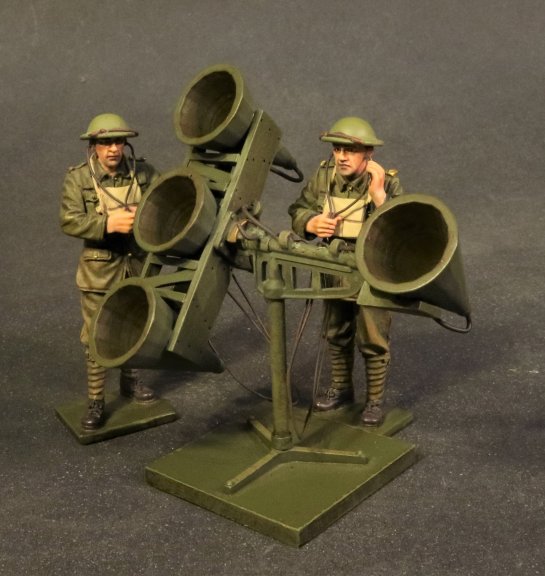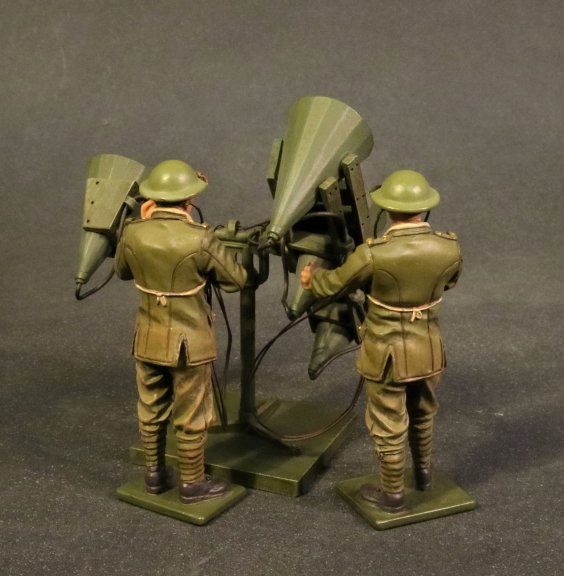- Joined
- Feb 2, 2011
- Messages
- 2,093
NEW RELEASES FOR JUNE 2020
THE KNIGHTS OF THE SKIES
Acoustic Location devices were used by military services from mid-WW1 to the early years of WW2 for the passive detection of approaching enemy aircraft by listening for the noise of their engines. These typically consisted of large acoustic horns attached to stethoscope-type earphones worn by monitors.
The first use of this type of equipment was claimed by commander Alfred Rawlinson of the Royal Naval Volunteer Reserve, who in the autumn of 1916 was commanding a mobile anti-aircraft battery on the east coast of England. He needed a means of locating Zeppelins during cloudy conditions and improvised an apparatus from a pair of gramophone horns mounted on a rotating pole. Several of these pieces of equipment were able to give a fairly accurate fix on the approaching airships, allowing the guns to be directed at them despite being out of sight.
Although no hits were ever recorded by using this method, Rawlinson claimed to have forced a Zeppelin to jettison its bombs on one occasion.

BGC-34
KNIGHTS OF THE SKIES,
ALLIED GROUND CREW AND ACCESSORIES,
ACOUSTIC LOCATOR.
(4pcs)
Extract from Canadian War Museum website:
“The Mk 1 Sound Locator was manufactured by A.W. Gamage Ltd. in Britain during the first World War. In the early days of the First World War, anti-aircraft defence was a totally new field. The detection of unseen incoming aircraft was a major problem. The only possible solution with the technology available at the time was sound detectors, which could provide a rough idea of an aircraft's direction and height based upon the sound of its engine. Tubes connected the bases of two horizontally mounted gramophone-style horns to a pair of stethoscope earpieces. An operator moved the detector until the sound was heard equally in each ear, at which point (theoretically) it would be pointed in the direction of the aircraft. A second operator used the vertically mounted horns to estimate height. The system was rudimentary at best, however, as the location of the aircraft could only be established for the time that the sound was recorded. After a sound contact was made, laborious calculations were then required to properly aim an anti-aircraft gun, and any deviation in the aircraft's flight path rendered the system useless. It was, however, the only system available for detecting the approach of unseen aircraft until the development of radar in the 1930s.”

Tubes connected the bases of two horizontal, gramophone-style horns to a pair of stethoscope earpieces. An operator moved the detector until he heard sound equally in each ear, at which point, ideally, the guns could be pointed in the direction of the aircraft. The two vertical cones estimated the target's height.
Improved forms of this instrument were still in use in 1939-1940, before being superseded by radar.
Many thanks to Scott Dummitt and the Canadian War Museum for their help in reproducing this unique piece of Great War technology.
**PLEASE CONTACT YOUR LOCAL DEALER FOR FURTHER INFORMATION**
THE KNIGHTS OF THE SKIES
Acoustic Location devices were used by military services from mid-WW1 to the early years of WW2 for the passive detection of approaching enemy aircraft by listening for the noise of their engines. These typically consisted of large acoustic horns attached to stethoscope-type earphones worn by monitors.
The first use of this type of equipment was claimed by commander Alfred Rawlinson of the Royal Naval Volunteer Reserve, who in the autumn of 1916 was commanding a mobile anti-aircraft battery on the east coast of England. He needed a means of locating Zeppelins during cloudy conditions and improvised an apparatus from a pair of gramophone horns mounted on a rotating pole. Several of these pieces of equipment were able to give a fairly accurate fix on the approaching airships, allowing the guns to be directed at them despite being out of sight.
Although no hits were ever recorded by using this method, Rawlinson claimed to have forced a Zeppelin to jettison its bombs on one occasion.

BGC-34
KNIGHTS OF THE SKIES,
ALLIED GROUND CREW AND ACCESSORIES,
ACOUSTIC LOCATOR.
(4pcs)
Extract from Canadian War Museum website:
“The Mk 1 Sound Locator was manufactured by A.W. Gamage Ltd. in Britain during the first World War. In the early days of the First World War, anti-aircraft defence was a totally new field. The detection of unseen incoming aircraft was a major problem. The only possible solution with the technology available at the time was sound detectors, which could provide a rough idea of an aircraft's direction and height based upon the sound of its engine. Tubes connected the bases of two horizontally mounted gramophone-style horns to a pair of stethoscope earpieces. An operator moved the detector until the sound was heard equally in each ear, at which point (theoretically) it would be pointed in the direction of the aircraft. A second operator used the vertically mounted horns to estimate height. The system was rudimentary at best, however, as the location of the aircraft could only be established for the time that the sound was recorded. After a sound contact was made, laborious calculations were then required to properly aim an anti-aircraft gun, and any deviation in the aircraft's flight path rendered the system useless. It was, however, the only system available for detecting the approach of unseen aircraft until the development of radar in the 1930s.”

Tubes connected the bases of two horizontal, gramophone-style horns to a pair of stethoscope earpieces. An operator moved the detector until he heard sound equally in each ear, at which point, ideally, the guns could be pointed in the direction of the aircraft. The two vertical cones estimated the target's height.
Improved forms of this instrument were still in use in 1939-1940, before being superseded by radar.
Many thanks to Scott Dummitt and the Canadian War Museum for their help in reproducing this unique piece of Great War technology.
**PLEASE CONTACT YOUR LOCAL DEALER FOR FURTHER INFORMATION**

